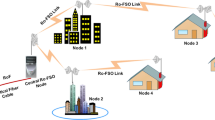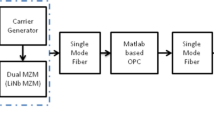Abstract
Radio over free-space optics (RoFSO) communication system is useful for different applications where optical fibers are not possible, like in rural areas, to provide wireless services easily and more effectively. Radio over free-space optics framework is one of the developing advancements toward the 5G networks. With the consistent increase of data and media associations, radio frequency (RF) range has additionally expanded, and subsequently, there emerges a need to move from RF carrier to optical carrier. Additionally, the RoFSO innovation can be applied as an all-inclusive technology for both the fiber and free-space optical communication systems and in this manner stretching out broadband network to underserved regions. In this work, we characterize the performance of a millimeter waves RoFSO link considering different modulation techniques for 5G applications. Quality of received signal has been analyzed as function of transmission range, transmitted power, data rate, and beam divergence considering different modulation formats.
Access provided by Autonomous University of Puebla. Download conference paper PDF
Similar content being viewed by others
Keywords
1 Introduction
Free-space optics (FSO) manages the exchange of data through free-space medium between transmitter and receiver. Data is being transferred by propagation of light in this environment. It works like optical fiber cables, with the main difference that transmission of data through FSO does not require guided medium links [1]. As a result of wireless communication technique, it also faces a set of difficulties in reliable transmission of signals as compared to optical fiber cables. In this technique, a narrow beam of light launched at the transmitter station goes through the air and afterward received at the receiver’s station. Transmitters and receivers need to be in an appropriate line of sight (LoS) view for avoiding loss of information [2].
As of now, huge development and progression has been seen in information exchange and data communication. As the use of video conferencing, fast Web, and so forth has expanded to a more noteworthy degree, the transfer speed requirements have also been increased [3]. With the consistent increase in data and media associations, utilization of radio frequency (RF) range has additionally expanded, and subsequently there have emerged a need to move from RF carrier to optical carrier [4]. Optical carrier does not require any spectrum authorizing and hence is an attractive possibility for high data transfer capacity applications [5].
Radio over fiber (RoF) and radio over free-space optics (RoFSO) are the two innovations that can be applied for optical fiber and free-space optical communication systems, respectively [6]. In addition, RoFSO communication is one of the preferred one compared to other accessible choices for executing 5G [7]. It has numerous points of interest like permit free, high transfer speed and information rate, simple sending, less working cost, and high security [8, 9].
RoFSO is a minimal effort, more effective, high transmission capacity, and free-space optics (FSO)-based framework for giving rapid communication joins (100 Gb/s) to associate versatile base stations without the need of fiber links [10]. This innovation proves to be useful where the links are not possible because of significant expenses.
In this paper, the characterization of millimeter waves RoFSO link has been performed for 5G applications. Quality of the received signal has been analyzed as a function of input power, bit rate, propagation range, and beam divergence considering different modulation schemes.
2 System Design
OptiSystem is used to design the RoFSO framework. The design incorporates a transmitter, FSO channel, and a receiver. The target of the design is to generate modulated RF signal, and the resulting from the RF signal and the optical carrier generated from CW laser is modulated and is then fed to FSO channel. The transmitter section comprising of user bit sequence generator, NRZ modulator, CW laser, Mach–Zehnder modulator, and DPSK sequence generator. The bit sequence generator generates 10 GB/s. Then, the duo-binary phase shift keying (DPSK) modulated scheme is utilized for extending the spectral efficiency of the framework. The signals coming from the DPSK modulator is then sent to M-ray pulse generator for converting into M-ray pulse and afterward is modulated using 60 GHz RF carriers. The output RF signal is modulated with optical carrier (laser), i.e., CW laser with frequency 193.1 THz by the Mach–Zehnder modulator (MZM) and is then fed to FSO channel under the downpour climate conditions. The laser diode has wavelength of 1550 nm. For the FSO channel, the range is set up to 1 km as a default value. The signal transmits through FSO, transmitter power being 0 dBm, and divergence angle being 2 mrad. The receiver comprises of a PIN photodetector with 1 A/W responsivity, and 10 nA dark dull current is utilized for detection of the optical signal prior to transmission through the filter headed by following the PIN photodetector. A low pass Bessel filter cuts off the higher frequency components and thereby the filter noises from the signal. The BER analyzer analysis the performance and indicates the quality of the signal by of the minimum BER or Q-factor. Modulation techniques play a vital role in the characterization of RoFSO link [11].
2.1 Modulation Techniques Chosen for Analysis
-
DPSK: In differential phase shift keying (DPSK), the phase of the regulated signal is moved comparative with the past signal component. No reference signal is considered here. The signal phase follows the high or low condition of the past component. The DPSK technique need not require a reference oscillator.
-
QPSK: The quadrature phase shift keying allows signal to transfer double the information as normal PSK using the same bandwidth, which sends two bits of computerized data one after another called as bigits.
-
BPSK: Binary phase shift keying (BPSK) utilizes two stages which are isolated by 180°, thus can likewise be named 2-PSK. It is generally DSBSC modulation technique, for message being the digital information.
-
QAM: Quadrature amplitude modulation (QAM) is a method for combining two amplitude modulated (AM) signals into a single channel, in this way doubling the effective transmission. QAM is utilized with pulse amplitude modulation (PAM) in advanced frameworks, particularly in remote applications (Fig. 1).
3 Simulation Results
The aim of this work is to study characterization of RoFSO link considering different modulation techniques and internal parameters of the system. The global parameters of the system have been listed in Table 1.
The Q-factor has been analyzed for different modulation techniques (DPSK, QPSK, QAM, BPSK) as function of transmission range, transmitted power, data rate, and beam divergence.
We can observe from plot in Fig. 2 that the quality factor varies with the range for different modulation techniques. As it is observed, Q-factor constantly decreases with the increase in range. The least quality factor is obtained in BPSK modulation scheme. The range is taken from 0 to 5000 m. Maximum quality factor is obtained in DPSK modulation, and it is shown with the red curve in plot. Q-factor is about 1500 at a range of 1000 m, and an acceptable signal quality is achieved at a distance of 5000 m with this modulation scheme. Minimum is seen in BPSK with a value of Q-factor 700 at 1000 m and about 300 at 2000 m.
We can observe from the plot in Fig. 3 that the value of Q-factor varies with power for different modulation techniques. As it is observed, Q-factor constantly increases with power. Q-factor is observed by varying input power from −10 to 0 dBm. Here, DPSK shows the maximum value of quality factor, with increase up to a Q-factor 1300 at 0 dBm power. QPSK shows peak value of Q-factor of 950. Least value of Q-factor is observed in case of BPSK with peak value of 700 at 0 dBm power. Hence, the effective modulation technique is DPSK as it shows the highest quality factor.
We can observe from the plot in Fig. 4 that the value of Q-factor varies with the change in data rate for different modulation techniques. As it is observed, Q-factor constantly decreases with data rate. The least value of Q-factor among all modulation techniques is BPSK, and 8-QAM, 16-QAM, QPSK modulation techniques performed better than this. The data rate is taken from 1 to 10 Gbps. Maximum value of quality factor is obtained with DPSK modulation shown with the red line in the plot. The value of quality factor is about 1400 at data rate 1 Gbps with DPSK. QPSK, 8-QAM, 16-QAM, and BPSK types of modulation techniques show the variation of Q-factor with respect to bit rate. Minimum is observed in case of BPSK which shows Q-factor 750 at 1 Gbps and about 300 at 3 Gbps.
We can observe from the plot in Fig. 5 that the value of quality factor varies with the beam divergence for different modulation techniques. As it is observed, Q-factor constantly decreases with the increase in beam divergence. Least value of quality factor among all modulation techniques is observed in case of BPSK modulation technique. The beam divergence is taken from 0.5 mrad to 3.5 mrad. Highest Q-factor is observed with DPSK modulation, which is shown with the red line in the graph. The value of Q-factor is more than 1300 at 0.5 mrad beam divergence for this scheme.
QPSK, 8-QAM, 16-QAM, and BPSK types of modulation techniques show variation of Q-factor with respect to beam divergence. Minimum is observed in case of BPSK which shows the value of Q-factor 700 at 0.5 mrad and about 330 at 1.3 mrad.
Figure 6 indicates the eye diagram of received signal in case of BPSK modulation scheme at a data rate and range of 1 Gbps and 1 km, respectively.
The clear opening of eye of BER analyzer with a Q-factor 176.08 indicates successful transmission of data with acceptable BER and Q-factor.
Figure 7 indicates the eye diagram of received signal in case of BPSK modulation scheme at a data rate and range of 10 Gbps and 5 km, respectively. The quality of the signal has deteriorated in this case as compared to Fig. 6 as distance as well as data rate has been increased in this observation.
The clear eye opening with a Q-factor 21.91 indicates successful transmission of signal with acceptable BER and Q-factor in this case.
4 Conclusion
As to conclude the paper, characterization of millimeter waves RoFSO link for 5G application has been analyzed. Five different modulation techniques have been studied to analyze the performance of the FSO system with specific visibility range, data rate, power, and beam divergence as system design parameters.
The Q-factor was evaluated and plotted for each of the modulation schemes, and it is observed that DPSK and BPSK are maximum and least efficient techniques in terms of quality of received signal. Q-factor observed is about 1400 at a data rate of 1 Gbps with DPSK technique. Yet, minimum is seen in case of BPSK which shows Q-factor 750 at 1 Gbps and about 300 at 3 Gbps. 8-QAM, 16-QAM, and QPSK modulation techniques performed better than BPSK in all cases.
The clear eye opening with a Q-factor 21.91 indicates successful transmission of signal with acceptable BER and Q-factor in case of BPSK modulation format at 10 Gbps, with a transmission range of 5 km.
References
Tabassum N, Franklin N, Arora D, Kaur S (2018) Performance analysis of free space optics link for different cloud conditions. In: 4th international conference on computing communication and automation (ICCCA), August 2018, pp 98–101
Kazaura K, Wakamori K, Matsumoto M, Higashino T, Tsukamoto K, Komaki S (2010) RoFSO: a universal platform for convergence of fiber and free-space optical communication networks. IEEE Commun Maga 48(2):130–137. https://doi.org/10.1109/MCOM.2010.5402676
Salehi J (1989) Code division multiple-access techniques in optical fiber networks. I. fundamental principles. IEEE Trans Commun 37(8):824–833, 45–89
Saito Y, Kishiyama Y, Benjebbour A, Nakamura T, Li A, Higuchi K (2013) Non-orthogonal multiple access (NOMA)for cellular future radio access. In: IEEE 77th vehicular technology conference (VTC Spring), June 2013, pp 1–5
Kizilirmak RC, Rowell CR, Uysal M (2015) Non-orthogonal multiple access (NOMA)for indoor visible light communications. In: 4th international workshop on optical wireless communications (IWOW), Sep 2015, pp 98–101
Bloom S, Korevaar E, Schuster J, Willebrand H (2003) Understanding the performance of free-space optics. J Opt Network Conf 2(6):105–196
Mishra B, Gajal L, Kaur S (2019) Analysing the performance of terrestrial FSO link for different internal parameters of the system. In: SPIN 6th International conference on signal processing and integrated networks, August 2019, pp 56–75
Manickam S, Kaur K, Chaudhary S (2018) Millimeter waves over free space optics system for 5G application. J Opt Commun, pp 28–56
Kaur S, Kakati A (2018) Analysis of free space optics link performance considering the effect of different weather conditions and modulation formats for terrestrial communication. J Opt Commun. https://doi.org/10.1515/joc-2018-0010
Adnan SA, Ali M, Ali A (2018) Characteristics of RF signal in free space optics (RoFSO) considering rain effect. J Eng Appl Sci 13(7):1644–1648, pp 14–86
Dang J, Zhang Z, Comparison of optical OFDM-IDMA and optical OFDMA for uplink visible light communication
Author information
Authors and Affiliations
Corresponding author
Editor information
Editors and Affiliations
Rights and permissions
Copyright information
© 2021 The Author(s), under exclusive license to Springer Nature Singapore Pte Ltd.
About this paper
Cite this paper
Vishnu Kartik, M., Samal, M., Arora, S., Kaur, S. (2021). Characterization of Millimeter Waves RoFSO Link for 5G Applications. In: Goyal, V., Gupta, M., Trivedi, A., Kolhe, M.L. (eds) Proceedings of International Conference on Communication and Artificial Intelligence. Lecture Notes in Networks and Systems, vol 192. Springer, Singapore. https://doi.org/10.1007/978-981-33-6546-9_5
Download citation
DOI: https://doi.org/10.1007/978-981-33-6546-9_5
Published:
Publisher Name: Springer, Singapore
Print ISBN: 978-981-33-6545-2
Online ISBN: 978-981-33-6546-9
eBook Packages: EngineeringEngineering (R0)











